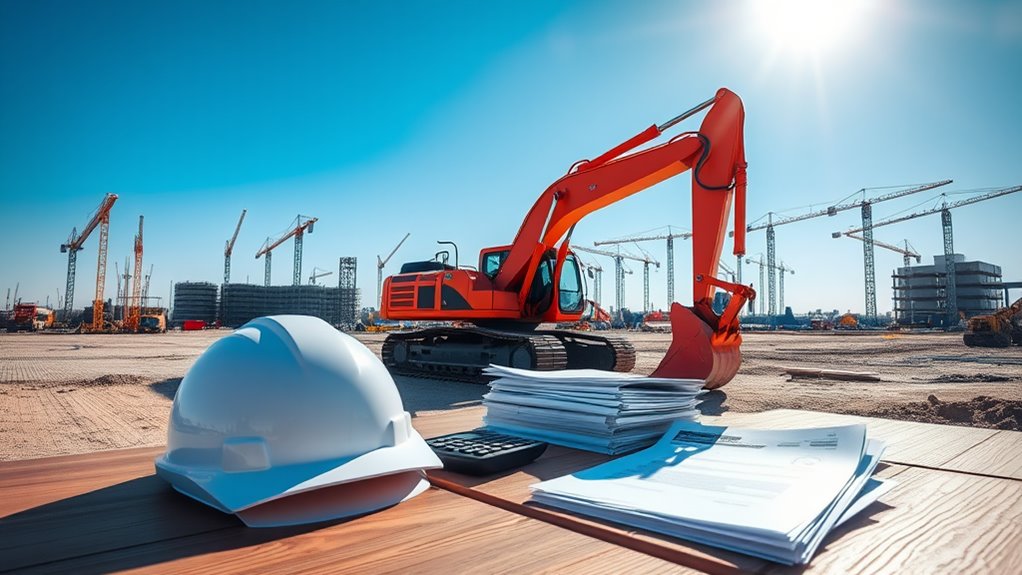When it comes to managing your construction business, understanding vehicle insurance costs is essential. These expenses can considerably impact your overall financial health, as premiums vary based on factors like vehicle type and liability risks. By evaluating your unique risk profile and local regulations, you can determine the coverage levels that work best for you. But what strategies can you implement to mitigate these costs effectively?
When you manage a construction business, understanding insurance costs for your vehicles is fundamental, as these expenses can greatly affect your bottom line. The types of coverage you need, including liability insurance, physical damage, and extensive coverage, play a considerable role in determining your overall costs. The construction industry varies widely; for instance, insuring heavy equipment will likely yield different rates than insuring personnel vehicles. Additionally, having a solid understanding of SR-22 insurance can be beneficial for business owners who may face specific legal obligations regarding vehicle insurance.
As you assess your insurance needs, remember that higher liability risks—stemming from potential accidents or damages—can lead to increased premiums. You'll also find that policy requirements can change based on the specific contracts or projects you undertake. Some jobs may mandate additional coverage, which can inflate your costs. In addition, local regulations can impose specific insurance requirements that you must adhere to, adding another layer of complexity to your budgeting.
Higher liability risks and specific project requirements can significantly impact your insurance premiums and overall budgeting.
When evaluating insurance costs, consider the types of vehicles you use. Trucks, cranes, and specialized equipment each come with their own risk profiles that influence insurance premiums. Usage patterns are important too; vehicles that see frequent use or operate in high-risk environments tend to incur higher costs. If your construction vehicles are based in urban areas, you'll face different risk factors than those operating in rural settings, affecting your premiums. Furthermore, insurance costs for construction vehicles may vary significantly based on trucking type.
Implementing safety measures can help you mitigate some of these costs over time, as insurance companies often reward businesses that prioritize safety. On average, you might expect to pay between $215 and $257 per month for commercial insurance as a contractor. However, these rates can fluctuate considerably depending on factors like vehicle type, industry, and coverage levels. Keep in mind that vehicles with high-value equipment generally attract higher premiums.
While adequate liability coverage is fundamental to protect against potential claims, remember that higher deductibles can reduce monthly costs but increase your out-of-pocket expenses when you file a claim. Risk management strategies are essential for controlling insurance costs. Regular driver training can reduce the likelihood of accidents, potentially lowering your premiums. Maintaining your vehicles in good working order is another important aspect, as well-maintained vehicles are less prone to accidents.
Installing safety equipment, such as rearview cameras, can also help minimize risks and may lead to reduced premiums. Additionally, utilizing telematics to monitor driving behaviors can be an effective way to manage risks. Lastly, explore your options for policy discounts. Bundling multiple insurance policies can lead to cost savings, as can insuring several vehicles under one policy.
If you maintain a claims-free record, you might qualify for further discounts. Some insurance carriers may even provide incentives for implementing robust safety programs. Furthermore, consider the advantages of paying annually instead of monthly, as this can lead to small yet meaningful savings over time. By understanding these factors, you can make informed decisions that align with your business goals.
Conclusion
In the complex landscape of construction vehicle insurance, think of your coverage as a sturdy blueprint. Just as every beam and bolt supports a structure, each policy detail safeguards your business. By grasping the nuances of premiums, risks, and safety practices, you can build a robust financial foundation. Investing time in understanding these costs not only protects your assets but also paves the way for a more secure and profitable future in construction.

